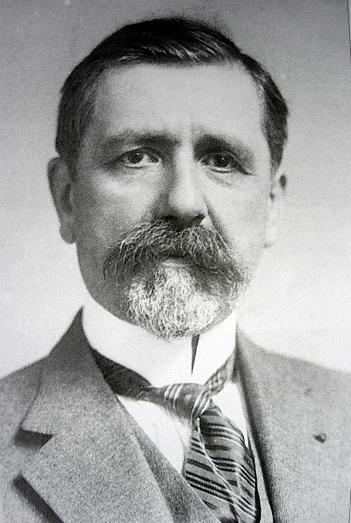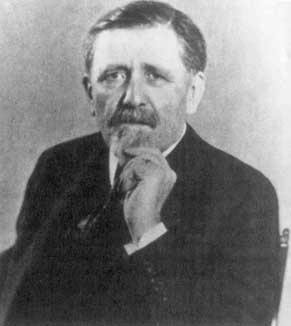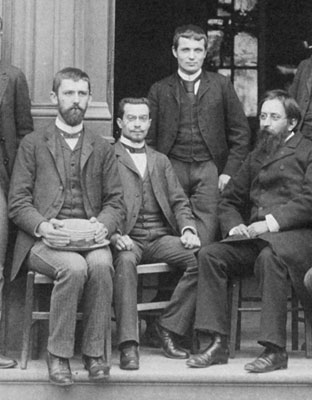<Back to Index>
- Mathematician Félix Édouard Justin Émile Borel, 1871
- Painter Albert Bierstadt, 1830
- King of Bavaria Ludwig III, 1845
PAGE SPONSOR



Félix Édouard Justin Émile Borel (7 January 1871 – 3 February 1956) was a French mathematician and politician.
Borel was born in in Saint-Affrique, Aveyron. Along with René-Louis Baire and Henri Lebesgue, he was among the pioneers of measure theory and its application to probability theory. The concept of a Borel set is named in his honor. One of his books on probability introduced the amusing thought experiment that entered popular culture under the name infinite monkey theorem or the like. He also published a number of research papers on game theory. In 1913 and 1914 he bridged the gap between hyperbolic geometry and special relativity with expository work. In the 1920s, 1930s, and 1940s he was active in politics. From 1924 to 1936, he was a member of the French National Assembly. In 1925, he was Minister of Marine. During the Second World War he was a member of the French Resistance. He died in Paris in 1956.
Emile Borel's father was Honoré Borel who was a Protestant minister. Honoré Borel himself was the son of a craftsman from Montauben, the capital of Tarn-et-Garonne in the Midi-Pyrénées region. Emile's mother was Emilie Teissié-Solier who was the daughter of a rich wool merchant from Saint Affrique. Emilie's father was opposed to her marrying a minister, wanting her to marry a rich landowner from the district. As a result he disinherited her and bad feeling existed between Emilie and her father. At the time Emile was born, his parents were living in a fine eighteenth century house in which Honoré Borel had a school for the children of Protestant families in the neighbourhood. Honoré and Emilie had two daughters who were much older than Emile, being sixteen and fourteen years old when he was born. Honoré Borel was an intelligent man and for the first years of his son's life he educated him at home. When Emile was eleven years old he left home in Saint Affrique and went to live with his eldest sister, Madame Lebeau, who was married to a minister from Montauben. This meant that he was able to attend the Lycée at Montauben. There he showed extraordinary talents and, several years later, went to Paris as a bursar to the Collège Sainte-Barbe. While studying there, he attended courses at the Lycée Louis-le-Grand in preparation for taking the examinations to enter the École Polytechnique and the École Normale. He had the distinction of being ranked first in both these examinations and could choose either of the two universities. He also took first prize in the Concours Général. One might have expected this achievement to cause high praise to be heaped on the brilliant schoolboy. However:-
The
spectacular feat attracted a good deal of publicity, not all of it
sympathetic. For there was a sneering reference by a prominent man to
the ephemeral nature of schoolboy success and its quickly fading
laurels with a challenge to the young champion to show himself in ten
years time. Before half that time had passed the ungenerous critic
could have been made to look foolish ...
Family friends urged Borel to enter the École Polytechnique, which was considered the more prestigious establishment, but he had other ideas. The family friends were merchants and industrialists, and their advice was to aim at an occupation where he would make a lot of money. Borel was advised that a degree from the École Polytechnique would give him the best opportunities for a job in industry or business. He, however, had very strong views that he wanted a job in science, particularly in mathematics, and he was sure that the best opportunities for such a position would be achieved by studying at the École Normale. He did have the support of his father for his decision, entering in 1889. We should mention a significant factor in his decision. While at the Lycée Louis-le-Grand he had met Gaston Darboux's son who was a pupil there. The two became firm friends and through the Darboux family Borel came to know leading mathematicians of the day, in particular Emile Picard who he later remarked was a major influence on him at this time.
While studying at university he undertook military service with the engineers at Montpellier for a while but he seemed to be able to do this without too much disruption to his mathematical work. He published his first two mathematical papers in 1890. These were fairly minor works but still remarkable for a young undergraduate student just starting his studies. In 1892 he was awarded the agrégation in mathematics and in the same year his sixth paper, which is his first major memoir, was published. One year later he was awarded his doctorate after submitting his thesis Sur quelques points de la théorie des fonctions. His thesis advisor was Gaston Darboux. Collingwood writes about this published thesis:-
... the theory of measure, Borel's theory of divergent series, his theory of non-analytic continuation and the theory of quasi-analytic functions all derive from ideas which make their first appearance in this paper. And it contained the explicit statement and proof of the famous covering theorem which, quite inappropriately, acquired the name of the Heine-Borel theorem ...
Later Borel spoke about the mathematicians who had influenced him most in his early years mentioning, among others, Camille Jordan, Emile Picard, Paul Appell, Edouard Goursat, Paul Painlevé and Marcel Brillouin.
At almost exactly the same time that he was receiving his doctorate, when still only 22 years of age, Borel was appointed Maître de Conférence at the University of Lille. He spent three years at Lille during which time he published 22 papers, with several others in the hands of the printer when he left. It was not only the quantity that is amazing but also the remarkable quality of the work that he produced. He returned to Paris in January 1897 when appointed Maître de Conférence at the École Normale Supérieure. Later in 1897 he was joint secretary at the first International Congress of Mathematicians held in Zurich from 9 August to 11 August.
Borel achieved much over the next years, both in his career and in the outstanding mathematics which he produced. From 1899 to 1902 he taught at the Collège de France and was reserve for the Cours Peccot. He was appointed examiner for entry to the École Navale in 1900, holding this position for ten years. He was awarded the Grand Prix of the Academy of Sciences in 1898, he was awarded the Poncelet Prize in 1901, he received the Vaillant Prize in 1904, and the Petit d'Ormcy Prize in 1905. Also in 1905 he was elected president of the French Mathematical Society.
In October 1901 he had married Marguerite Appell, daughter of the mathematician Paul Appell. They had no children but adopted one of Borel's nephews, Fernand Lebeau, the son of his eldest sister who he had lived with while a pupil at the Lycée at Montauben. Both his sister and her pastor husband had died young and, tragically, Fernand was later killed during World War I. Marguerite Borel was an outstanding author, writing under the pen name Camille Marbo (Marbo being the first three letters of Marguerite and the first two of Borel), and received the distinction of being awarded the Prix Femina in 1913 for La Statue voilée.
In 1909 Borel was appointed to a chair of Theory of Functions created specially for him at the Sorbonne and he went on to hold this professorship until 1941. The year 1910 saw him attain the prestigious position of Deputy Director of the École Normale Supérieure, on the death of Jules Tannery, which he held for ten years. He later said that he regarded this appointment as the greatest honour he had received up to that time. During World War I he volunteered for military service and commanded an artillery battery:-
On the outbreak of war, as his students left for the front, he had organised a project partly in Paris and partly at the front on sound-ranging; but in 1915 Painléve, then Minister of War, placed him in charge of a central department of research and inventions and later, when Prime Minister, appointed him Secretary-General in the Cambinet Office. On the fall of Painléve in 1917, Borel returned for a time to the front ...
In 1918 he received the Croix de Guerre for his efforts for his country during World War I. However returning to his position at the École Normale after the war ended proved emotionally very difficult for him. Half of his students had been killed, and his own adopted son had also been killed in the war. He resigned as Deputy Director of the École Normale in 1920 and this period marks a change in direction in both his career and in his research interests. In 1921 he was elected to the Académie des Sciences, becoming its vice-president in 1933 and its president in 1934. Also in 1921 he was appointed to succeed Joseph Boussinesq in the chair of Probability and Mathematical Physics and, in the following year, he founded the Institut de Statistique de l'Université de Paris (Institute of Statistics at the University of Paris). In 1928, with financial support from Rockefeller and Rothschild, he set up the Institut Henri Poincaré (the Centre Emile Borel is now part of the Institute) and he ran the Institute for thirty years.
Borel's mathematical work is divided into the following topics: Arithmetic; Numerical series; Set theory; Measure of sets; Rarefaction of a set of measure zero; Real functions of real variables; Complex functions of complex variables; Differential equations; Geometry; Calculus of probabilities; and Mathematical physics. Borel created the first effective theory of the measure of sets of points. This work, along with that of two other French mathematicians, René Baire and Henri Lebesgue, marked the beginning of the modern theory of functions of a real variable. Borel, although not the first to define the sum of a divergent series, was the first to develop a systematic theory for a divergent series which he did in 1899. After 1905 he became interested in the theory of probability. In addition to many textbooks, Borel published more than fifty papers between 1905 and 1950 on the calculus of probability. They were mainly motivated or influenced by Poincaré, Bertrand, Reichenbach, and Keynes. However, he took for the most part an opposed view because of his realistic attitude toward mathematics. He stressed the important and practical value of probability theory. He emphasized the applications to the different sociological, biological, physical, and mathematical sciences. He preferred to elucidate these applications instead of looking for an axiomatization of probability theory. Its essential peculiarities were for him unpredictability, indeterminism, and discontinuity. Nevertheless, he was interested in a clarification of the probability concept.
In addition, between 1921 and 1927, Borel published a series of papers on game theory and became the first to define games of strategy. During this period, however, he had already embarked on a political career. He wrote an important political work in 1924 La politique républicaine:-
... and began the struggle for a united Europe, and with unbending optimism continued it for the rest of his life. ... In the meantime he joined the Republican-Socialist Party, the group to which Briand and Painlevé belonged, and was elected deputy for Aveyron in 1924, for St Affrique in 1928.
He published many outstanding works over the years including Leçons sur la théorie des fonctions (1898), Leçons sur les séries entières (1900), Leçons sur les fonctions divergentes (1901), Leçons sur les fonctions de variables réelles et les développements en séries de polynômes (1905), Le Hasard (1913), Leçons sur les fonctions monogènes uniformes d'une variable complexe (1917), L'Espace et le temps (1921), Méthodes et problèmes de la théorie des fonctions (1922), L'espace et le temps (1922), Traité du calcul des probabilités et ses applications (1924-1934), and Principes et formules classiques du calcul des probabilités (1925).
After 1924, Borel became active in the French government serving in the French Chamber of Deputies (1924-36) and as Minister of the Navy (1925-40). During World War II he continued to produce mathematical works of great originality such as Valeur pratique et philosophique des probabilités (1939), (with André Chéron) Théorie mathématique du bridge à la portée de tous (1940), Le jeu, la chance et les théories scientifiques contemporaines (1941), Les probabilités et la vie (1943), and Evolution de la mécanique (1943). However he was also involved in fighting with the Resistance and he was arrested and imprisoned at Fresnes for a month in 1941, but soon released. After his imprisonment under the Vichy regime he continued working for the Resistance. After the war, he was awarded the Médaille de la Résistance with rosette, and the Grand Croix Légion d'Honneur (1950). In 1946, when he was 75 years old, Borel published the fascinating book Les paradoxes de l'infini. But further works were to come from his pen such as Eléments de la théorie des ensembles (1949), Les nombres inaccessibles (1952), and L'imaginaire et le réel en mathématiques et en physique (1952). He also made:-
... a number of valuable contributions to the knowledge of Einstein's theory of relativity.
Further roles were given to this distinguished man such as being elected as a member of the Bureau des Longitudes in 1946 and being made president of the Science Committee of UNESCO in 1948. For his scientific work he received the first gold medal of the Centre National de la Recherche Scientifique in 1955.